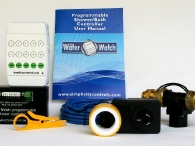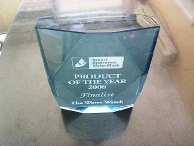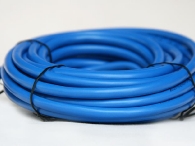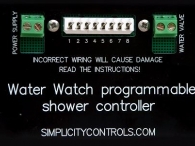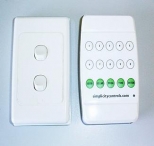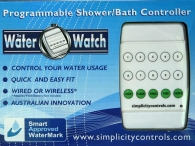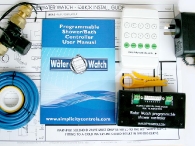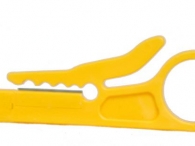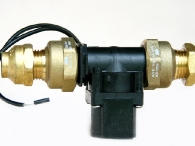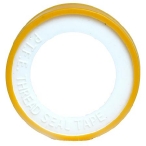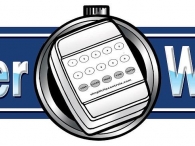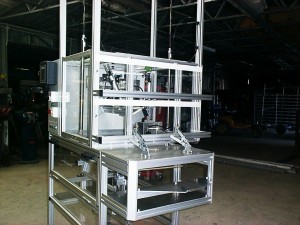Archive for the ‘Control’ Category
General information
There are several devices on the market to restrict shower use. But they don’t necessarily work. Experience has shown that many people who shower under a rose fitted with a water restricting device, simply stand there twice as long, totally negating any benefit from the device. The Water Watch takes the decision from them, and makes sure they are “done and dusted” in the shortest time possible. Even teenagers who make up a large percentage of the offenders learn to be more careful of water use.
Most people in Australia are aware of our current water shortages and are doing things at a household level. A short stroll through the plumbing section of your local hardware/DIY chain store will always find people in the plumbing section looking for ideas on how to save or reuse water.
That is why we have come up with the Water Watch. We call it that because we feel it is watching over the most valuable resource on the planet, fresh water. With declining water supplies in many areas of the world, including Australia, the world’s driest continent, anything that allows us to stretch the resource should be considered. That is the function of the Water Watch. The benefits of fitting a Water Watch are:
-
An immediate decrease in water consumption
-
An immediate decrease in energy consumption
-
Savings on both energy and water bills
-
Better bathroom utilisation in busy periods.
-
An increased environmental awareness by users
A Water Watch will pay for itself in time, the length of which will depend on your usage, energy and water prices. The more you are using at present, the faster the payback. There is also a less tangible benefit to parents. It seems every family that has children old enough to shower alone has at least one member who is a shower “hog”. This is a source of extreme frustration to parents and can cause unnecessary divisiveness in the family unit, especially in peak usage times. This problem can be totally eliminated, just by the installation of a Water Watch.
Installation is quite easy for a home handy man or woman, although you will have to check the local regulations that apply in your area to see if trades people are required to assist at all. As there are so many possibilities we could not cover them all on this website, but comprehensive installation instructions and ideas are included as part of the kit. You can also glean more information from the install page in this section.
The stand out feature of this device is the ability to program it for individual users, and to be able to change that program easily. Imagine the possibilities for overstaying house guests, or kids that won’t keep their room tidy !
For really hot pricing for a short time, look at the news page.
The Simplicity Date Stamping Machine
The story.
The evolution of this machine has been brought about by necessity. As we also own and run Fancyleaf (see the links bar) which is a South East Queensland Benchmark hydro producer, we had a pressing need to find an answer to the problem of applying a date stamp to the sleeves we pack our Woolworths product into.
It is totally impractical to place this date stamp on the sleeve after the product (fancy lettuce in this case) has been picked, as we have developed picking trolleys for the deployment of the returnable plastic crates we use so as to have them at waist height in front of each picker.
This has meant using what are commonly called checkout guns, or price guns to place a small sticker on each sleeve with a “best before” date on it. The area where this is done (on any farm) invariably becomes covered in orphaned stickers as each gun only holds a roll of 1,000. To reload the gun it is necessary to remove a few stickers from the backing paper first and they get everywhere.
Oh, did I mention how mind numbingly boring this task is? Humans doing this task soon get sick of being careful to stamp each bag, so misses, quite often in large amounts, are inevitable. Â And don’t forget to factor the labour cost of this job into your production costs.
We asked professional machinery builders to look at doing something for us, and the answer came back that it was simply too difficult, or could not be done at all. So, we had to do it ourselves. The result is 2 machines, the label applicating machine and the print directly on the sleeve machine.
The 2 machines are very similar up to a point and it is only a close inspection that reveals the difference. The first machine uses a pneumatic labelling gun and simply mechanises the process. Advantages over a normal gun are label rolls of 5,000 instead of 1,000 and a slightly quicker speed than the higher end model. We have also found no “adhesive bleed” into the gun which seems normal when using by hand. The disadvantages ? Well they are still labels, they still get “lost” sometimes which means all over themachine, plus we have found they don’t want to stick in the middle of winter. Plus the consumable cost is high and ongoing.
The slightly more expensive machine prints the date directly onto the sleeve, doing away with the label altogether, at the cost of being ever so slightly slower than the cheaper model. Consumables for this machine are negligible and easily changed in about 5 seconds, with no messy solvents and inks to worry about.
A medium sized air compressor is required for operation, as well as connection to mains electricity.
DIRECT PRINT MACHINE
The above video is of the direct print machine, the one below is of the machine that prints labels onto the sleeve. After using hand labelling guns and knowing all the dramas that go along with them, why would you bother with labels, it is far better to print the best before date directly onto the sleeve, especially when you don’t need to use expensive and high maintenance inkjet printers.
LABELLING MACHINE
The production model is shown below. It is built using a profile system, has been independently risk assesed and certificated and will give you many years of valuable service.
A sample contract if you wish to view our terms can be found here
|
Simplicty Economical as we call it is the little brother to Simplicity. It is a more basic control system, with inbuilt limitations, but with some astute programming, you can do a surprising amount with it. As the units only accept the older style voltage inputs there are a limited number of sensors available. The heart of the system are mini PLC’s which are quite economical. They will accept some analogue inputs and some digital inputs. There are several models to chose from, with either 10 or 20 I/O’s. |
|||
| The smaller of the two units with 6 inputs and 4 relay (10 amp) outputs | The larger unit with 20 I/O’s including 12 analogue and digital inputs and 8 switched relay outputs. | ||
| Programming is by means of function blocks, which are very easy to learn, especially when you already have a program done for you, and you learn by editing and changing that program. It is as easy as drag and drop. This means you can create exactly the program that fits your application, instead of using something off the shelf that is never exactly right for what you want to do. | |||
| We stock a couple of common environmental sensors such as temperature and humidity, as well as light. These have voltage outputs accepted by the mini PLC’s | |||
|
Temperature and humidity sensor with 0-10 volts DC output. |
Light sensor with the cover removed, again with 0-10 volts DC output. Quite a neat unit for the price. |
||
|
These PLC’s can be networked together using a 485 bus system, which can be set up to give you remote access and some control, but it is mainly for monitoring. Unfortunately each unit cannot “talk” to other units directly, so an output from one unit can be used as an input to another to achieve much the same result. However, for the outlay they are quite good and we have found them extremely reliable so far. |
|||
Simplicity Full Function (see hydro dosing for more info)
Why should I be considering this system?
-
Custom Build We specialise in custom applications that solve your “can’t find exactly what I want dilemma.” We spend the time to get to know your requirements so developing the code is right first time.
-
Flexibility The use of smart sensors will change the world of control in coming years. We have already incorporated the future in our applications. While the world is coming to grips with smart sensors, our hardware partner, Monitor Sensors, has been making them for years.
-
Economy You may well be able to run your custom application from existing hardware, saving you set up costs. No PLC’s are required. Our total costs are among the lowest in the world.
-
Power All Simplicity applications are extremely powerful, and due to the strength of the communications bus used, unbreakable. No reflections or weird happenings from hum and distortion as we have seen on some high speed buses.
-
Access Simplicity applications can be accessed over the internet, from wherever you can find an web connection. You can observe, change and control via the web interface. Alarm interfaces which are user settable will ring your mobile with a spoken message telling you exactly what is not within your set parameters.
-
Sensors A full range of sensors is available that are compatible with the communications bus, robust and affordable. Monitor Sensors have specialised in sensors for agriculture and horticulture for many years.
-
Protection Simplicity applications can have multiple sensors looking at each other and comparing themselves to protect against sensor failure. Any system will eventually have a failed sensor(s) at some time and this will protect against that occurrence. Another small application can simply listen to the sensor “chatter” on the bus and alarm if it stops.is essential for stable, ongoing use, and in the Monibus we believe we have found the best. It certainly is not the fastest in the world, but that is actually its’ strength. And it is fast enough for most applications with 4″ to 6″ sensors being “talked to or polled” every second.
A robust communications bus
System basics: (see glossary for explanation of any terms you do not understand).
The base: Simplicity 2 runs on a software platform or “base”. You need to configure your PC to run Microsoft .NET which is an easy process, then you can install specific Simplicity modules, to your own requirements. All modules share the same base, so adding modules later is very easy. You can upgrade your application at any time your requirements change.
The bus: Simplicity consists of a low voltage wired bus connecting various devices. We use Monibus because of its’ inherent stability. The minimal power required for the bus (as low as 5 volts DC) can come from several sources, the most usual is simply a power supply plugged into the mains electricity grid. The minimum for a system is one comms box and one of the others that follow it below. Plus of course the software “base” and the custom application.
Comms box: The interface between the PC and the bus is done by a communications unit which we call the comms box. This allows the PC to “talk” to the bus using our own protocol. Commands flow through it as the application is working, as well as data from the attached devices coming back to the PC. One side of the comms box is attached to the 3 bus wires, the other to a port on the PC.
Relay box: Full name relay outputs unit. There are 8 separate channels or relays in this unit which can all be independently switched to turn things on and off. Each box and each channel has it’s own address so is unique from the others. Each relay is capable of switching small devices that operate on low power such as solenoids or door strike locks, or switch a larger relay for higher voltage devices. Commands to turn relays on or off are sent down the bus by the comms box, which also will ask the relay box the position of all relays on a regular basis, as a checking mechanism.
Inputs box: Full name inputs unit. Again 8 channels. Basically, when voltage is sensed a LED lights up. This is seen by the micro processor and transmitted as an ON state. The simple explanation for these inputs is that low voltage is taken to a digital switch which is on or off. Low voltage is then taken from the other side of the switch back to the input channel. When the switch is ON that voltage will flow back to the input channel and the state of that channel will be recorded as on. The input box will send any change in status of any of its channels to the application immediately.
Sensors: A full range of environmental and other sensors is offered. All sensors are “µsmart” which means they each have their own micro processor onboard. This means all can be separately addressed and added to the communications bus at any point.
Simplicity Full Function Summary
-
Flexibility using smart sensors allows the whole application able to be more flexible.
-
Sensors We have access to the full range of sensors for any purpose from the one company, all compatible with our applications.
-
Economy Lower install costs, as sensors can be wired to the bus anywhere, they do not have to be wired to an inputs board.
